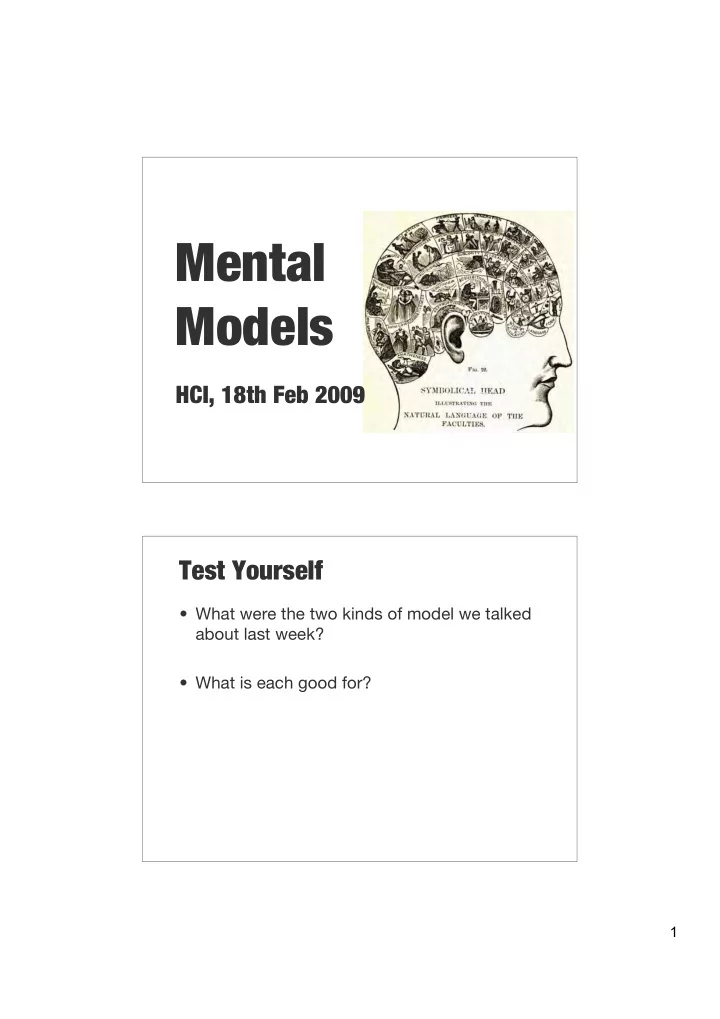

Mental Models HCI, 18th Feb 2009 Test Yourself • What were the two kinds of model we talked about last week? • What is each good for? 1
Fitts’ Law Test Results What is Cognition? 2
Components of Cognition • Attention • Perception and recognition • Memory • Learning • Reading, speaking and listening • Problem solving, planning, reasoning & decision making Information Processing Model (Card 1983) 3
Mental Models A B C D E 7 6 5 4 3 (From Norman, 1988) 4
A B C D E 7 6 5 4 3 (From Norman, 1988) A B C D E Normal settings C 5 Colder fresh food C 6-7 Coldest fresh food B 8-9 Coldest freezer D 7-8 Warmer fresh food C 4-1 Off (fresh food & 0 freezer) 7 6 5 4 3 (From Norman, 1988) 5
A B C D E 7 6 5 4 3 (From Norman, 1988) 6
When would it be useful to have a mental model as a user? A model of... • how the system works • what its components are • how they are related • what the internal processes are • and how they affect the components (Carroll & Olson 1988) 7
2 Kinds of model • Surrogate - a model that mimics the output of a system, but not the internal workings. • Metaphor models - you understand a product by comparing it to something else that you already know. How do we find out what a user’s mental model is? 8
How could we use this information for design? Mental models mediated by system image User Designer System System image (From Norman, 1988) 9
BREAK 5 mins Your Homework An example of one of the models. 10
Practical Task • See if you can find evidence for Mental Models in the way people use interactive products. • Ask the person to show you how they use a product. Ask them to explain what they are doing as they use it. Try stopping them from time to time and asking what the think the product will do (and why) before they make an action. Then when they take the action, ask them if the response of the product matches their expectations. • Prepare a short presentation for next week’s discussion. Critical Questions • Do people really have Mental Models? What separates a Mental Model from everyday knowledge? • Focusing on mental representations can divert attention from the many other resources people use to help them when using interactive products. What about other people, or physical resources? • How much does this actually help designers? Does it change the problem of design to the problem of uncovering the correct model? 11
Next Week’s Readings • Norman, D., 1999. Affordances, Conventions and Design. Interactions, 6(3), 38-43. • Djajadiningrat, T., Overbeeke, K. & Wensveen, S., 2002. But how, Donald, tell us how?: on the creation of meaning in interaction design through feedforward and inherent feedback. In Proceedings of the conference on Designing interactive systems. ACM Press, pp. 285-291. Image Credits • How to Read Character: A New Illustrated Hand-Book of Phrenology and Physiognomy, for Students and Examiners; with a Descriptive Chart. (New York, Fowler & Wells Co., Pubs., 1891) • http://www.flickr.com/photos/glenscott/1578514678/ • www.flickr.com/photos/erica_marshall/ 12
Recommend
More recommend